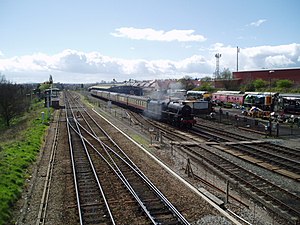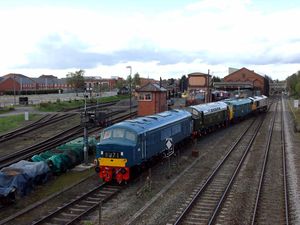Difference between revisions of "Connection to Network Rail"
(Add more early preservation stuff) |
(→Early preservation history: additional info) |
||
| (4 intermediate revisions by 2 users not shown) | |||
| Line 7: | Line 7: | ||
==Early preservation history== | ==Early preservation history== | ||
| − | In the earliest days of preservation the boundary of the SVR's section of the railway was at [[Alveley Sidings]], where a length of rail was normally removed to ensure no unauthorised movements took place. When [[Railcar 22]] was delivered in 1967, for example, platelayers had to temporarily replace the missing rail before it could be propelled onto the SVR's section.<ref> A G Cleaver, "The Early Days Of The 'Severn Valley'", ''SVR News'' 190 (2015) p24.</ref><ref name=SVR6>SVR News 6</ref> | + | In the earliest days of preservation, the connection from the BR main line onto the goods yard and the branch to Bewdley and beyond was wholly controlled by BR's [[Kidderminster Junction signal box]]. The boundary of the SVR's section of the railway was at [[Alveley Sidings]], where a length of rail was normally removed to ensure no unauthorised movements took place. When [[Railcar 22]] was delivered in 1967, for example, platelayers had to temporarily replace the missing rail before it could be propelled onto the SVR's section.<ref> A G Cleaver, "The Early Days Of The 'Severn Valley'", ''SVR News'' 190 (2015) p24.</ref><ref name=SVR6>SVR News 6</ref> |
| − | In | + | In addition, although BR passenger services to [[Bewdley]] continued to 1970, the SVR had a presence in [[Bewdley Down Yard]] from at least 1968. A video of [[BR Riddles 4MT 80079|80079]] being delivered in 1971 by a BR locomotive to Bewdley from [[Barry Scrapyard]] is available on [https://youtu.be/ckKvZhxPvuE YouTube] (external link). |
| − | At its opening in 1987, the SVR's Kidderminster signal box worked to [[Kidderminster Junction signal box]], 'over the fence' and operated successively by BR, RailTrack and finally NR. The operating method was cumbersome, requiring staff on the track for any movement between the two railways. Under this arrangement the SVR's exchange line was designated as a siding. | + | In the 1973-1984 period prior to the extension to Kidderminster, the arrangements at Kidderminster remained unchanged, with the BR/SVR boundary becoming the [[Ground Frames at Foley Park|trap points at Foley Park]]. When the SVR initially [[The development of Kidderminster Town Station | took possession of the former BR Kidderminster goods yard]] in 1984 there were four connections to BR at various points. Three redundant connections were soon recovered, retaining only the exchange line connection.<ref name=SVR73>SVR News 73</ref> |
| + | |||
| + | When Kidderminster Town station first opened in July 1984, the connection between BR and the SVR remained under the control of Kidderminster Junction signal box.<ref>SVR News 72</ref> The station layout was controlled by a small [[Kidderminster ground frame |ground frame]], released by the train staff, which gave access to the sidings, the run-round loop and the BR exchange line.<ref name=SVR73/> The BR connection was commissioned for passenger traffic on 12 December 1974, with the first through working taking place on 29 December.<ref>[[Bibliography#Books|Marshall (1989)]] p. 195.</ref> | ||
| + | |||
| + | At its opening in 1987, the SVR's Kidderminster signal box worked to [[Kidderminster Junction signal box]], 'over the fence' and operated successively by BR, RailTrack and finally NR. The operating method was cumbersome, requiring staff on the track for any movement between the two railways. Under this arrangement the SVR's exchange line was designated as a siding. | ||
==2012 upgrade and current arrangement== | ==2012 upgrade and current arrangement== | ||
| Line 26: | Line 30: | ||
On Network Rail's open data TRUST timetabling system the SVR is 'Kidderminster S.V.R.' and the [[Diesel Depot]] is 'Kidderminster Tmd (Svr)'. Trains across the network connection are shown on independent sources of live realtime running information. | On Network Rail's open data TRUST timetabling system the SVR is 'Kidderminster S.V.R.' and the [[Diesel Depot]] is 'Kidderminster Tmd (Svr)'. Trains across the network connection are shown on independent sources of live realtime running information. | ||
| + | |||
| + | <gallery mode=packed heights=400px style="text-align:left"> | ||
| + | Real traintimesJune 2024.png | Real Train Times showing mainline arrival on the SVR across the network connection | ||
| + | </gallery> | ||
A description of the work with images can also be found in [http://www.svrsig.org.uk/svr/Iss180.htm SVR News 180, on S&T Notes online]. | A description of the work with images can also be found in [http://www.svrsig.org.uk/svr/Iss180.htm SVR News 180, on S&T Notes online]. | ||
Latest revision as of 15:49, 7 June 2024
For a description of the network connection signalling, see Kidderminster station signal box.
The Exchange Line is a short length of track just outside Kidderminster terminus allows the through running of trains between the SVR and Network Rail (NR).
Contents
Early preservation history
In the earliest days of preservation, the connection from the BR main line onto the goods yard and the branch to Bewdley and beyond was wholly controlled by BR's Kidderminster Junction signal box. The boundary of the SVR's section of the railway was at Alveley Sidings, where a length of rail was normally removed to ensure no unauthorised movements took place. When Railcar 22 was delivered in 1967, for example, platelayers had to temporarily replace the missing rail before it could be propelled onto the SVR's section.[1][2]
In addition, although BR passenger services to Bewdley continued to 1970, the SVR had a presence in Bewdley Down Yard from at least 1968. A video of 80079 being delivered in 1971 by a BR locomotive to Bewdley from Barry Scrapyard is available on YouTube (external link).
In the 1973-1984 period prior to the extension to Kidderminster, the arrangements at Kidderminster remained unchanged, with the BR/SVR boundary becoming the trap points at Foley Park. When the SVR initially took possession of the former BR Kidderminster goods yard in 1984 there were four connections to BR at various points. Three redundant connections were soon recovered, retaining only the exchange line connection.[3]
When Kidderminster Town station first opened in July 1984, the connection between BR and the SVR remained under the control of Kidderminster Junction signal box.[4] The station layout was controlled by a small ground frame, released by the train staff, which gave access to the sidings, the run-round loop and the BR exchange line.[3] The BR connection was commissioned for passenger traffic on 12 December 1974, with the first through working taking place on 29 December.[5]
At its opening in 1987, the SVR's Kidderminster signal box worked to Kidderminster Junction signal box, 'over the fence' and operated successively by BR, RailTrack and finally NR. The operating method was cumbersome, requiring staff on the track for any movement between the two railways. Under this arrangement the SVR's exchange line was designated as a siding.
2012 upgrade and current arrangement
In 2012 NR upgraded signalling on the adjacent main line, which included the closure of its Kidderminster Junction box and transfer of control to West Midlands Signalling Centre (WMSC) at Saltley.
The SVR took the opportunity to extensively upgrade the connection, with many hundreds of hours of work by NR and SVR S&T technicians. Commissioned in August 2012, to coincide with the mainline resignalling, it installed a comprehensive connection with the alterations allowing access for passenger- and non-passenger trains coming onto or leaving the SVR.
As part of the resignalling of the network connection, the exchange line was upgraded from a siding to a running line. Movements can be made from the SVR exchange line onto the NR Down Main, and from the NR Up & Down Mains onto the SVR exchange line. In addition, an incoming or outgoing train may be held on the exchange line awaiting a path, without it affecting trains on the SVR or NR main lines. All such movements are now locked and signalled, controlled by the WMSC in conjunction with the SVR's Kidderminster signal box, which is now a fringe box of the WMSC. Movements do, therefore, require the SVR's signal box to be manned and open.

Kidderminster signal box diagram 2020, showing the network connection.
The upgrade also saw the first non-GWR/BR(W) signal installed on the SVR, in the form of a colour light signal leading from the SVR's exchange line onto either the national network or into the SVR's North Star Carriage & Wagon Works.
On Network Rail's open data TRUST timetabling system the SVR is 'Kidderminster S.V.R.' and the Diesel Depot is 'Kidderminster Tmd (Svr)'. Trains across the network connection are shown on independent sources of live realtime running information.
A description of the work with images can also be found in SVR News 180, on S&T Notes online.


